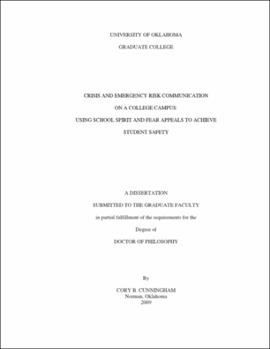| dc.description.abstract | In today's society where universities are viable targets for crises, it is imperative that school administrators communicate effectively with students and that those students, in turn, follow appropriate crisis and emergency risk procedures (National Summit, 2004). However, as is seemingly evident in cases such as Virginia Tech, the communication models currently employed by university officials are less than effective. The question then becomes, why? The current research was driven by two goals. The first, from a general communication perspective, was to explore the role of the receiver's perceptions of the sender on the acceptance or rejection of the crisis and emergency risk communication (CERC) message. The second, from an academic organizational context, was to test the effectiveness of Witte's (1992) extended parallel process model (EPPM) in predicting student response (acceptance or rejection) to CERC messages sent by university officials. By incorporating a quasi-experimental design, participants were asked to indicate their attachment to the university and respond to a series of hypothetical CERC email messages sent from university officials. The results indicated that although the EPPM is an appropriate tool for creating effective health risk messages aimed at changing behavior over time, it is not appropriate for creating CERC messages in the midst of a crisis. However, if a student has high organizational attachment (i.e., "school spirit") before a crisis occurs, then he or she will be more likely to follow safety instructions provided by university officials when the crisis does occur. Thus, the lesson for university officials is to put forth effort to increase students' organizational attachment now so that when faced with a crisis, the university can rely on its reputation and credibility to effectively keep its students safe. | |
